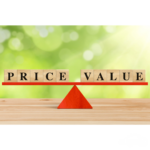As we’ve shared on this blog before, scale-up entrepreneurs are often so busy leading their companies through the Hyper-Growth phase of the Entrepreneurial Company Lifecycle™ that they neglect to step back from the day-to-day grind of running their businesses to consider what a perfect exit will look like. In our last blog post we discussed the importance of deliberate Exit Planning through which we visualize the exit and build a company that will have tremendous value in the marketplace. Among the possible acquirers for your company are strategic buyers (i.e., operating companies that are either in the same market or in a highly strategic adjacent market) and financial buyers (i.e., private equity and other buyers that allocate capital to growth companies with the intention of eventually selling the company a few years later, usually to a strategic buyer). As a growth company entrepreneur, is critical to understand the difference.
If you have a rapidly growing company and you have generated a buzz in your market (for example, through recognition on the Inc. 5000 list, or through industry networks) you have probably heard from (or will soon) private equity firms and other financial buyers who are interested in learning more about your company. Private equity firms and other financial buyers (for example, large family offices or “search funds”) are highly incentivized to generate “deal flow” and so they often reach out to high-growth companies (either on their own or through intermediaries, such as investment bankers who work both the buy and sell-side) in an effort to win the deal before there is any competition. Most private equity buyers are very good at what they do, and the attention they offer is often flattering to the unsuspecting entrepreneur. Unfortunately, many entrepreneurs believe (often at the urging of the very private equity investors who want to buy their company) that they can negotiate the deal on their own without running a more formal process. Doing so, however, almost always results in leaving significant value on the table.
Financial buyers utilize a somewhat rigid formula in valuing their targets. In short, they determine the adjusted cash flow of the target, apply a discount to those future cash flows, and then apply an industry multiple (based on things like recent transactions in the market) to arrive at the valuation. While there is a range of values that private equity buyers can pay (and through a competitive process they will occasionally pay a strategic multiple for high-value assets), left unchecked they will always pay at the lower end of that range so that they can maximize returns for their investors. This is not a criticism of private equity firms – indeed, their fiduciary duties to their limited partners require that they maximize returns – but their goals are not aligned with the goals of a growth company entrepreneur who is seeking to maximize value through a sale of her company.
While strategic buyers also look to a target’s financial performance as one measure of value, those who view acquisitions as a key to their growth strategy will also look for intangible qualities that will drive explosive growth in the future. In other words, where financial buyers (who almost always use debt to acquire companies) can only look at reasonably expected future cash flow and standard industry growth rates, strategic buyers will also factor in the value of a target company once it is integrated with the strategic buyer’s platform.
With this distinction in mind, the way to maximize value in an exit transaction is to identify the intangible qualities that are unique to your company and then connect with multiple strategic buyers who will fall in love with the possibilities presented by acquiring your company. We have also found that highly motivated private equity buyers who have a keen interest in particular industries (either because they have existing portfolio companies in the industry, or because they believe there are unique growth opportunities in a particular market) will pay strategic multiples for the right companies. The key to maximizing value, whether you ultimately sell to a financial or a strategic buyer, is to run a strategic process that highlights the unique aspects of your business and is focused on engaging with multiple potential buyers that will value your company more than they would using traditional industry metrics.
If you are interested learning more about the differences between financial and strategic buyers, please watch this video.
From time to time we hold small “mastermind” groups with CEOs like you where we go deeper on the subject of maximizing value upon exit. Please click here if you would like to learn about our next CEO Bootcamp.






